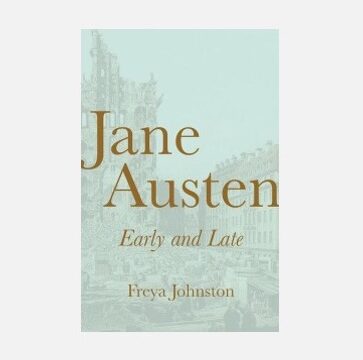Freya Johnston. Jane Austen, Early and Late. Princeton, NJ: Princeton University Press, 2021. 296 pages. ISBN 9780691198002. US $39.95 (hardcover).
Freya Johnston’s Jane Austen, Early and Late questions how we imagine time passing in the lives of authors by asking what can be gained if we understand writing as something continually revised, returned to, and done in response to others. Drawing on both her extensive knowledge of Jane Austen’s archives and research into the writer’s family and literary history, Johnston reframes Austen’s work by reading the author’s juvenilia, short texts, and other so-called minor writing in conversation with her six major novels. Instead of establishing a clear hierarchy that progresses from more ephemeral writing to the well-known novels, Johnston treats all of Austen’s writing as connected and essential to understanding this major figure of literary history.
To re-situate literary criticism and readership of Austen’s oeuvre, Jane Austen, Early and Late examines Austen’s “first known works and their reception” by focusing “on the dubious chronology of her compositions, her likely sources and influences, and her comic and stylistic repertoire, and on the relationship of her earliest known manuscript works to the later, celebrated novels” (p. 17). Johnston’s rejection of the traditional chronologies of biography is particularly important given that Austen’s life was an unconventional one for a woman of her time: she was a successful novelist who lived without many of the familiar milestones of nineteenth-century women’s lives, dying “without having had children or grown old” (p. 32).
The book’s first chapter, “Developing,” considers how Austen experienced the publishing of her work during her lifetime, and how we in turn receive her writings. The chapter asks: “Should we even construe a career in such terms—as moving from start to finish, from A to Z, when in truth many authors begin something, drop it, and return to it?” (p. 42) To answer this overarching question, the chapter explores an undated chronology of Jane Austen’s work by her sister Cassandra, though notes that this chronology, which omits “dates of publication,” obscures the “degrees of proximity or indeed overlap” of Pride and Prejudice, Sense and Sensibility, Mansfield Park, and Emma (p. 59).
Johnston’s next two chapters situate Austen within the broader literary context of her time. The second chapter, “Effusions of Fancy,” turns to Austen’s juvenilia, examining her “effusions” alongside the still-emergent genre of the novel. The effusion was a genre of short, light writing favored by women and often gathered into published collections. Johnston’s third chapter, “Reading and Repeating,” considers Austen’s literary influences, such as Alexander Pope and Jonathan Swift, and examines the changes in Austen’s writing style that led to her becoming known as an author.
Reflecting her circular rather than linear approach, Johnston turns to the end of Austen’s life in the middle of her book. The fourth chapter, “Dying with Laughter,” treats Austen’s death and her comedic talent by analyzing her final piece of writing, a comic poem written at the end of her life. The chapter also considers the relatively well-known unfinished “Sanditon” manuscript and finds in it a return to Austen’s “earlier hyperbolic mode” (p. 155) but no signs of her declining powers as a writer, despite her failing health. Johnston concludes that “in this, her last novel, Austen endorses her beginnings” (p. 157).
The fifth chapter, “Histories,” expands on Austen’s relationship with both social and literary history by taking up another comedic text, “The History of England,” which Johnston describes as “a self-possessed rampage through the lives of thirteen monarchs across four centuries” (p. 158). Written by Austen as a teenager, the work’s playful engagement with the history of monarchs illustrates that she understood “history [as] the servant of fiction” (p. 161). This chapter contains the only underdeveloped section of the book: Johnston’s discussion of womanhood and slavery in Mansfield Park and its historical context overlooks the social position of enslaved women and flattens the complex workings of Empire by stating that “[a]ll of them are evil” (p. 199). This vastly simplified statement might be true enough, but it is out of step with Jane Austen, Early and Late’s otherwise clear and precise analysis.
Finally, the sixth chapter, “The Village and the Universe,” asks why the relatively small plots of Austen’s novels hold such tremendous appeal. Reflecting on retellings and why we love Austen so much, Johnston writes that Austen, “[like Shakespeare] exhibits a strong consciousness that human lives, including those within her fictions, are at once confined by and something other than exemplary of the general truths they embody, or of the genres in which they appear” (p. 214). Johnston questions what we know about chronologies of authorship, life, and day-to-day literary production, and also sheds light on the often abrupt endings of Austen’s novels.
As one of the most celebrated British writers, Austen is easily eclipsed by hagiography for literary scholars, students, readers, and fans. This book provides a nuanced approach to her life and work, offering interesting new angles for reconsidering Austen and her writing. In a conclusion that offers a fresh perspective on the endings of Emma, Persuasion, and Pride and Prejudice, Johnston suggests that these texts exemplify something about the lasting impact of Austen’s work: the endings of these novels “show Austen’s characters thinking and feeling their way into a new life […] These people and their stories do not end. They grow” (p. 220).
Angelina Eimannsberger, University of Pennsylvania


